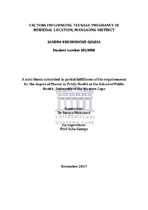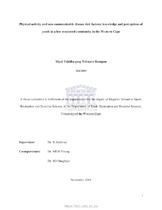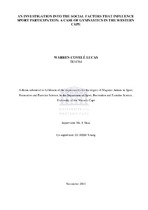| dc.contributor.advisor | Mohamed, Suraya | |
| dc.contributor.author | Qolesa, Sandra Kegomodicwe | |
| dc.date.accessioned | 2018-08-14T07:32:31Z | |
| dc.date.available | 2018-08-31T22:10:07Z | |
| dc.date.issued | 2017 | |
| dc.identifier.uri | http://hdl.handle.net/11394/6261 | |
| dc.description | Magister Public Health - MPH (Public Health) | |
| dc.description.abstract | Teenage pregnancy remains a complex issue globally. According to the World Health Organisation
(2014), the average global birth rate of girls aged 15-19 years was 49 per 1000 births reported
globally. In South Africa, the general household survey conducted in 2014 revealed that 5.6% of
females 14-19 years were reported to have been pregnant in 2013, with teenage pregnancy
increasing by age from 0.8% for the age group of 14 years to 11.9% for teenagers aged 19 years.
In South Africa, a range of health policies and programs exist to address teenage pregnancy,
including school-based sex education, peer education programmes, adolescent friendly clinic
initiatives and mass media interventions. Despite such initiatives, the number of teenagers becoming
pregnant remains high. Teenage pregnancy reported in Mangaung district is 7%, which is three
times more than the provincial target of 2% for teenage pregnancy. This research therefore aimed
to explore the reasons behind teenage pregnancy in Heidedal, Mangaung District, Free State
Province, South Africa.
Two in- depth interviews were conducted, one with twelve teenage mothers and the other with four
key informants who were selected based on insight and experience they possess in working with
teenagers. The key informants suitable for the study included a nurse, life orientation teacher, ward
councillor and a counsellor working for a non-governmental organization that supports the
implementation of youth programmes in the health facility. Thematic analysis was used to analyse
data and key themes, afterwards concepts were interpreted so that explanations could be constructed
to answer the research aim and objectives.
The study aimed to contribute to understanding reasons behind the high teenage pregnancy rates in
Mangaung District. This information will be useful to policy makers in developing policies and
strategies that will address factors identified to be influencing teenage pregnancy. | |
| dc.language.iso | en | |
| dc.publisher | University of the Western Cape | |
| dc.subject | Adolescent sexuality, Teenage pregnancy, Teenager, Influencing factors, Individual level factors, Social factors, Structural factors, Mangaung District, South Africa, Qualitative Research | |
| dc.title | Factors influencing teenage pregnancy in Heidedal location, Mangaung District | |
| dc.rights.holder | University of the Western Cape | |




